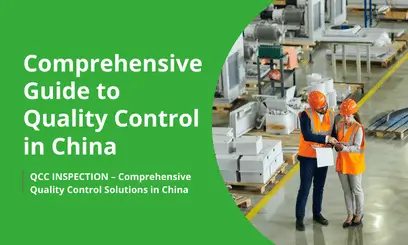How to Read AQL Sampling Tables
Mar 12,2025
Ensuring product quality is a top priority for manufacturers, suppliers, and quality control professionals. To achieve this, many industries implement standardized inspection methods that allow for systematic evaluation of production batches.
One of the most commonly used tools in quality assurance is the Acceptance Quality Limit (AQL) sampling table. This method helps determine the number of samples to inspect and the acceptable number of defects, balancing quality control with cost efficiency.
But when you receive AQL tables, how should you analyze it? Below, we will guide you on how to effectively read and interpret the table to ensure accurate inspection and decision-making.
Interpreting Defects Under Product Inspection
In product quality control, before discussing AQL, one critical aspect to understand is defects. In large-scale production, it is inevitable to find varying degrees of defective products, which directly impact the buyer’s financial outcomes.
Inspections are typically conducted in the form of final random inspections, providing buyers with an objective and measurable quality assessment of an upcoming shipment.
Based on inspection results, buyers can identify potential defects in the batch and make informed decisions regarding product acceptance and shipment arrangements.
Different buyers may have varying interpretations of defects, which are categorized into three types: critical defects, major defects, and minor defects. These definitions are usually outlined in an inspection protocol or quality manual to ensure consistency in execution.
Generally, the three defect categories are interpreted as follows:
- Critical Defects: Defects that violate mandatory regulations and/or pose safety risks to consumers or end-users. These defects are typically unacceptable.
- Major Defects: Defects that cause product malfunction and significantly reduce usability or marketability.
- Minor Defects: Deviations from quality standards that do not substantially impact functionality or marketability.
For example, discovering a broken glass shard in a set of drinking glasses would be classified as a critical defect, as it poses a significant safety hazard.
A misaligned zipper on a jacket that affects its functionality could be considered a major defect, while slight discoloration on a piece of furniture might be regarded as a minor defect.
Understanding these classifications allows businesses to make informed quality control decisions while balancing efficiency and cost-effectiveness.
What is AQL?
AQL (Acceptance Quality Limit) is a key concept in product quality control used to determine the maximum acceptable level of defects in a batch. AQL values help ensure that products meet customer standards—products with a higher AQL value allow more defects, while products with a lower AQL value require stricter quality control.
It is important to note that AQL values do not directly represent the actual defect rate calculated during inspection. Instead, they represent the maximum acceptable level of defects derived through statistical sampling methods. AQL is a statistical threshold used to predict and control product quality, based on sample inspection results.
In AQL inspections, the typical defect categories and their corresponding AQL values are:
- Critical Defects: AQL = 0 (Not Acceptable)
- Major Defects: AQL = 2.5
- Minor Defects: AQL = 4.0
Note: Unlike major and minor defects, Critical Defects always have an AQL of 0, meaning that even one critical defect in the sample will result in batch rejection. This is because critical defects typically pose safety hazards, legal non-compliance, or serious functional issues that cannot be tolerated.
AQL Inspection Levels
AQL sampling tables contain different inspection levels that define the sample size required for inspection.
These levels are divided into two main categories:
General Inspection Levels – These are the most commonly used levels, further subdivided into Level I, Level II, and Level III. Level II is the standard choice for most product inspections and is widely applied across industries.
Special Inspection Levels – These levels are used for specific inspection scenarios, such as S-1, S-2, S-3, and S-4. They are typically employed to reduce the sample size or perform targeted inspections, improving inspection efficiency under specific conditions.
Higher inspection levels require larger sample sizes, which increases the accuracy of quality assessments. However, this also adds to inspection time and cost, so it’s important to strike a balance between the rigor of the inspection and the cost efficiency.
What is an AQL Sampling Table?
An AQL sampling table is a standardized tool used in quality control inspections to determine the sample size and acceptance criteria for a given lot.
It provides a systematic method for evaluating a batch of products by inspecting a subset rather than the entire production. This method is particularly useful for large-scale manufacturing, where 100% inspection is impractical.
The AQL sampling table consists of two tables:
The first table lists different sample size code letters (A, B, D, etc.) based on the “lot size” and “inspection level“. Using this table, you can determine the sample size code letter to be used in the subsequent steps.
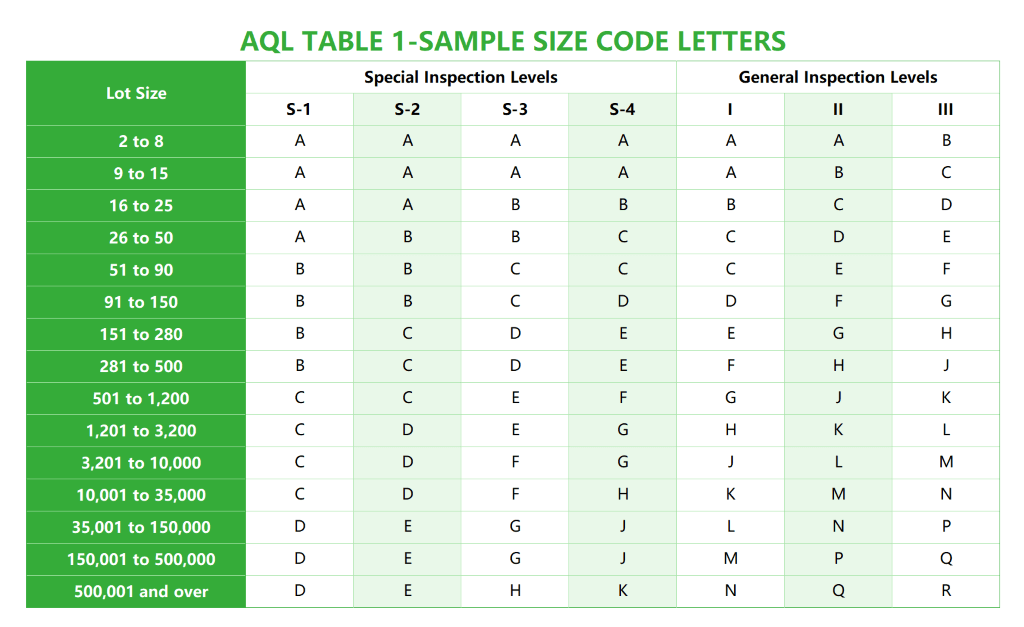
 How to Read and Use AQL Tables?
How to Read and Use AQL Tables?
Reading and using an AQL (Acceptance Quality Limit) table involves a series of well-defined steps to ensure accurate inspection and quality control. Follow these steps to determine the sample size and acceptable defect limits for your inspection:
Step 1: Understand Key Terms and Concepts
Before using the AQL table, it’s important to understand some basic terms:
Lot Size: The total number of units in the production batch that needs to be inspected.
Inspection Level: Defines the sample size based on the lot size, indicating how thorough the inspection will be. There are several inspection levels (e.g., Level I, Level II, Level III).
AQL Value: It is used in the AQL Table to determine the maximum number of acceptable defective products in a sample. Common AQL values include 2.5 for major defects and 4.0 for minor defects.
Step 2: Choose the Appropriate Inspection Level
The first step is to select an appropriate inspection level based on the risk associated with the product, customer requirements, or industry standards.
Generally, Level II is the most commonly used level for typical inspections, but higher-risk products may require Level III (more samples, more rigorous inspection), while low-risk products might use Level I (fewer samples).
Step 3: Locate the Lot Size in the AQL Table
Once you’ve determined the inspection level, you need to find the appropriate lot size for your product batch in the AQL table. The lot size is typically listed in ranges, for example, 0-500, 501-1,000, 1,001-3,000, and so on.
Step 4: Find the Sample Size Code Letter
Based on the lot size and inspection level, locate the corresponding code letter in the first part of the AQL table. This code letter will be used in the second part of the AQL table to determine the sample size and the maximum number of acceptable defects.
Example: For a lot size of 7,000 products and inspection level II, the corresponding code letter is “L.” Next, we will use “L” in the second part of the AQL table to find the specific sample size and acceptance criteria.
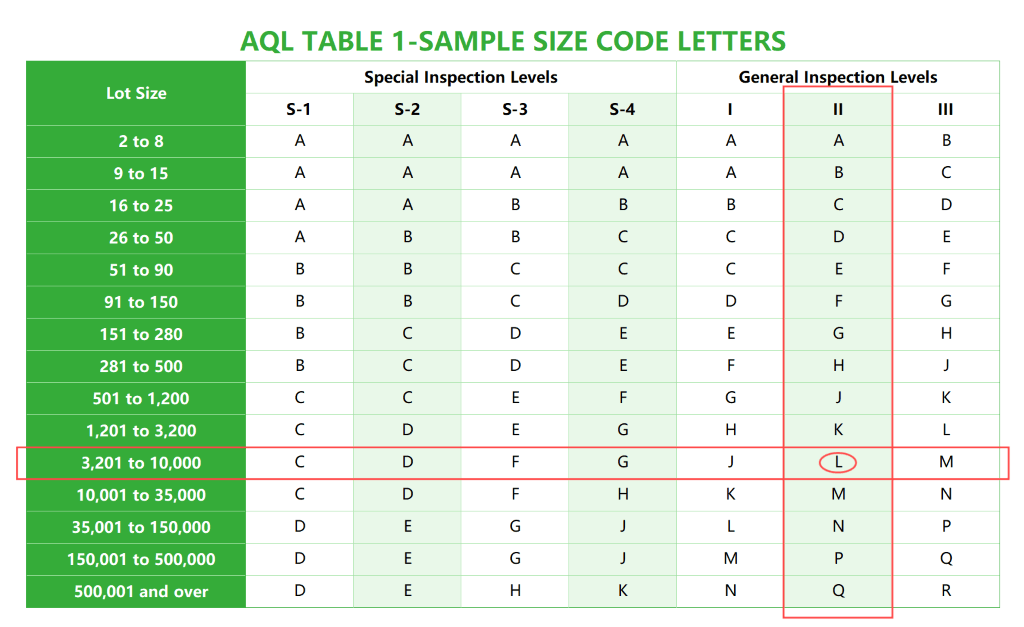
Once the code letter is identified, cross-reference it with the second part of the AQL table to determine the sample size and the maximum number of defects allowed.
Example: For a lot size of 7,000 products and inspection level II, the code letter has been determined as “L.” In the second part of the AQL table, the corresponding sample size is 200 units. When using AQL values of Major: 2.5 and Minor: 4.0, the acceptance limits are: Major defects: up to 10, Minor defects: up to 14. If the number of defects found exceeds these limits, the batch will be rejected.
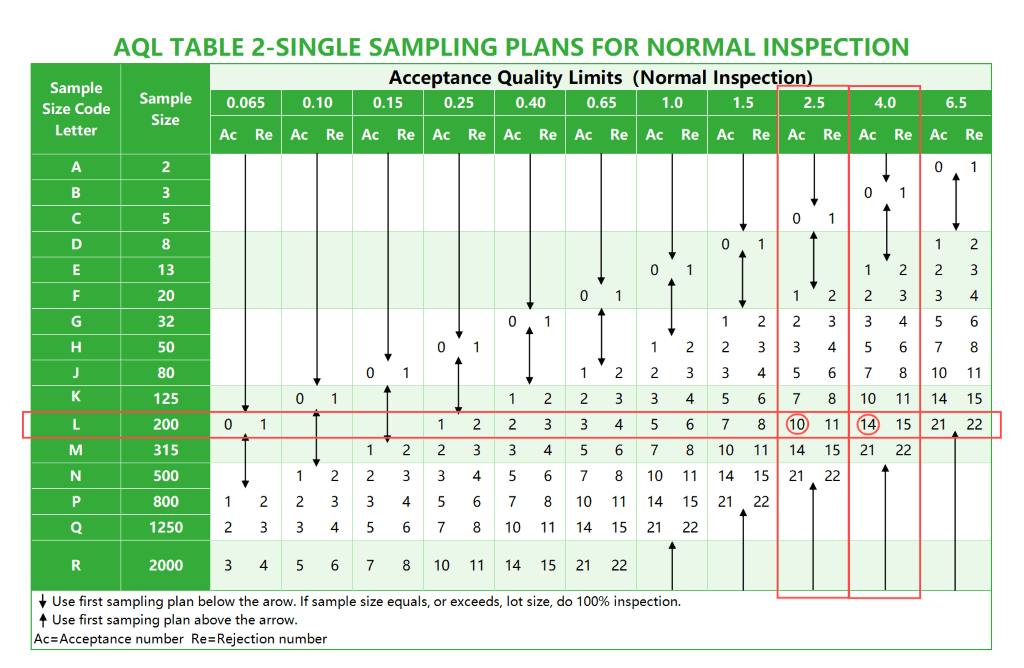
Using the sample size determined, proceed with inspecting the batch. Count the number of defects in each unit inspected. For each defect type (Critical, Major, Minor), compare the total number of defects found to the acceptance limits.
Step 7: Make the Decision
After completing the inspection, compare the number of defects found with the acceptance limits:
If the defects are below the acceptable limits, the batch passes the inspection.
If the defects exceed the acceptable limits, the batch is rejected, and corrective actions are needed.
How to Choose the Appropriate Inspection Level and AQL Value for Your Quality Inspection
First, it is important to understand the role and impact of inspection levels and AQL values:
Inspection Level: The inspection level determines the number of samples to be inspected. The higher the inspection level, the larger the sample size and the more stringent the inspection. Common inspection levels include Level I, Level II, and Level III. A lower inspection level (e.g., Level I) requires fewer samples to be checked, while a higher inspection level (e.g., Level III) requires more samples, ensuring higher inspection accuracy.
AQL Value: The AQL value represents the acceptable number of defects or defect rate, which directly impacts whether the lot is accepted. The lower the AQL value, the fewer defects are allowed, and the stricter the quality control. Common AQL value combinations include Major Defects AQL 2.5 / Minor Defects AQL 4.0. Choosing the appropriate AQL value determines the tolerance for defects and, thus, the product’s quality standards.
Understand the Product Risk Level
High-risk products, such as medical devices, aerospace components, or safety equipment, typically require the strictest inspection levels to meet compliance and safety standards. Lower-risk products may allow for more lenient inspections. At the same time, high-risk products generally require lower AQL values (indicating stricter defect tolerance) to minimize defects as much as possible.
Assess Production Consistency
If a manufacturer has a consistent history of high-quality production with minimal defects, a lower inspection level and a higher AQL value (allowing more defects) may be sufficient.
However, if production consistency is poor or if working with a new supplier, it is usually advisable to choose a higher inspection level and a lower AQL value (indicating stricter defect tolerance) to ensure quality standards are met.
Consider Industry and Regulatory Requirements
Certain industries have specific quality standards that must be followed. For example, the automotive and medical industries typically require strict AQL value combinations, such as Major Defects AQL 0.65 / Minor Defects AQL 1.0, while consumer electronics or clothing may have more flexible inspection standards, such as Major Defects AQL 2.5 / Minor Defects AQL 4.0.
Analyze the Impact on Cost and Quality
Higher inspection levels improve the accuracy of defect detection but increase the cost and time required for inspections. Companies need to weigh the benefits of a stricter inspection level (which increases sample size and inspection rigor) against the additional costs. A balance should be maintained to ensure quality goals are met without unnecessary expenditure.
Consider Customer Expectations
Some customers may have strict quality requirements and may request specific AQL values as part of their agreement. Understanding customer needs is essential for selecting the appropriate inspection level and AQL value.
For example, for high-value products, stricter combinations, such as Major Defects AQL 0.65 / Minor Defects AQL 1.5, may be necessary to ensure the highest quality standards.
Adjust Based on Supplier Performance
If working with a new or unreliable supplier, initially, a higher inspection level and lower AQL value may be necessary to ensure product quality. As the supplier’s performance improves and their production processes stabilize, you can adjust the inspection level and AQL value to better balance cost and quality.
By selecting the appropriate inspection level and AQL value, businesses can maintain a balance between quality assurance, cost-effectiveness, and industry compliance, ensuring that only acceptable products reach customers while optimizing operational efficiency.
Conclusion
Mastering the use of an AQL sampling table is essential for maintaining quality standards in manufacturing. By systematically selecting sample sizes, defining defect limits, and interpreting inspection results, businesses can achieve consistent product quality while optimizing inspection efficiency.
This methodology helps prevent defective goods from reaching customers and reinforces confidence in the production process.
--- END ---
Products
Get A Free Quote
Related Blogs
QCC SAMPLE REPORT
For sample reports or custom checklists, please contact us – we're here to assist you.

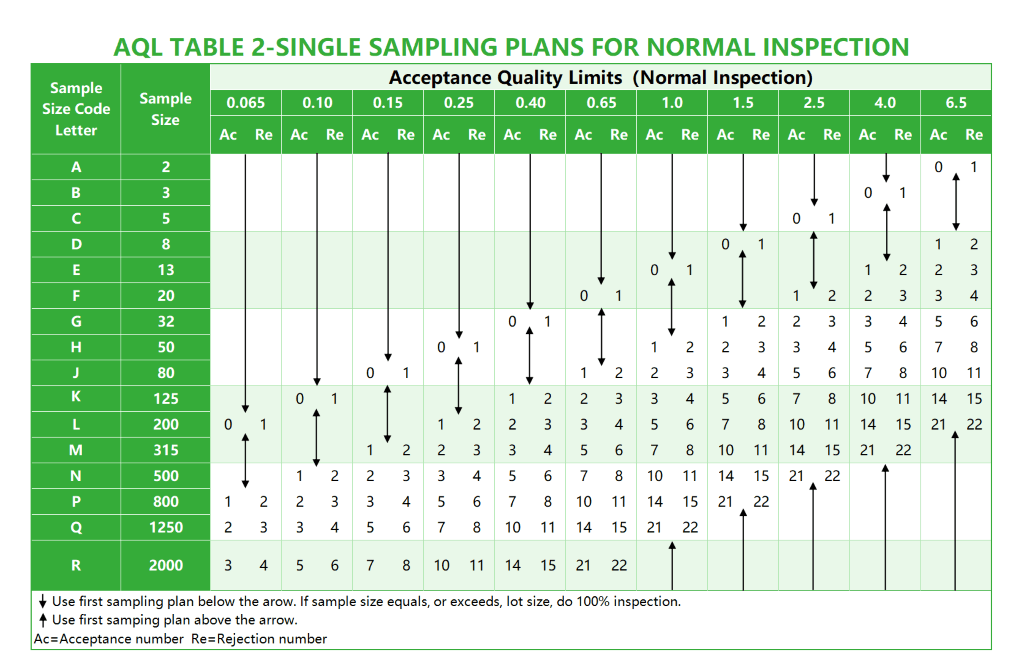 How to Read and Use AQL Tables?
How to Read and Use AQL Tables?
 April 05,2025
April 05,2025